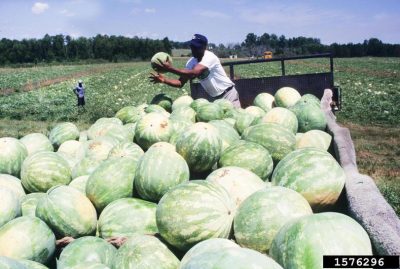
Watermelon harvest. Photo used with permission: Gerald Holmes, Strawberry Center, Cal Poly San Luis Obispo, Bugwood.org
June 20-21, 2025 marks the 69th year of celebrating the Panhandle Watermelon Festival in Chipley, Florida where you can enjoy free family friendly entertainment and compete in the Big Melon Contest for cash prizes. Whether you are a home gardener or a commercial watermelon producer, all are welcome to enter their largest ripe melon into the contest. Intake for the contest is at the Washington County Agriculture Center (1424 Jackson Ave, Chipley, FL) on June 18th from 8 a.m. – 4 p.m. CT and June 19th from 8 a.m. to 7 p.m. CT. More details can be found here. Now that you have watermelon picking on your mind, let’s talk about harvest and post-harvest practices that will maximize fruit qualify from field to fork.
Growing watermelons in North Florida is full of challenges: late frosts, cool soil temperatures, weeks of drought or non-stop rainfall, and a myriad of pathogens and pests. As the crop gets close to the finish line make sure you implement best management practices relating to harvest, handling, and shipping to help ensure the product of all your hard work reaches the consumer in the best condition possible.
–
When should you pick your melons?
You know our favorite answer in Extension is “it depends” and the deciding factor here is related to your intended market. Unlike many other crops, watermelon will not continue to ripen after picking, so make sure it is not immature (green tendril, white ground spot, small or irregularly shaped). However, it will continue to ripen by degrees while still on the vine. The more it ripens, the easier it is to damage the melon, so consider how much handling and how long the fruit may be in transport before it reaches your customer when deciding when to pick.
Cut watermelons from vine rather than twisting and splitting vines. As the watermelons are removed from the shelter of the vine, ensure that they are not left out in the sun where they will be subject to sunburn and high temperatures, which increases post-harvest decay susceptibility.
In Florida, it is common to store watermelons at ambient temperature, but if cold storage is necessary for shipping the ideal temperature range is 50˚F – 60˚F (10˚C – 15˚C) with <90% relative humidity. Once watermelons have been stored cold, they will need to remain refrigerated, or they will develop condensation, which also promotes decay. Also avoid exposure to high ethylene producing produce (apples, bananas, avocados, peaches, pears, and tomatoes) which can contribute to post-harvest decay.
You may have noticed that several practices mentioned in this article warn against conditions that promote or contribute to post-harvest decay. Two common post-harvest diseases that lead to decay in watermelon are black rot and stem end rot. Symptoms of black rot include green to black spots on the rind that expand as it reaches the watermelon flesh. This disease can also lead to secondary infection by bacteria and other fungal organisms. Stem end rot as the name implies occurs where the stem attaches to the vine. Infected watermelon tissue becomes soft and mushy then browns and shrivels. Both of these diseases are more common with mechanical injury, which offers the opportunity for pathogen entry into the melon – so, handle melons carefully while picking and loading. Warm, humid conditions, which are common at harvest time, favor both diseases; just another reason to be careful to avoid mechanical injury and keep the disease out of your melons. You may also want to read through the publication: Florida Crop/Pest Management Profile: Watermelon
As you wrap up watermelon season this summer, take care to handle watermelons properly to ensure a quality product reaches your buyer. Don’t forget to submit your melons on June 18th or 19th, and we hope to see you at the 2025 Panhandle Watermelon Festival in Chipley in June 20-21st!
- Post-Harvest Practices to Preserve Watermelon Quality - June 6, 2025
